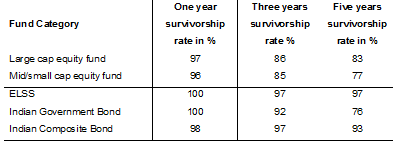Also, 23% of mid and small cap funds wound up in five years, says SPIVA.
Two out of ten large cap equity funds and mid & small cap equity funds failed to survive for five years, says a Standard & Poor’s Indices Versus Active Funds (SPIVA) report. In fact, large cap equity funds and mid and small cap equity funds had closure rate of 14% and 15% respectively over the past three years.
Experts attributed this trend to scheme mergers and poor performance of few funds.
Vidya Bala, Head – Mutual Funds Research, FundsIndia.com points out that SEBI had asked fund houses to merge similar looking schemes. Also, few poor performing funds have been merged with large funds within the same fund house, she adds.
Many fund houses have merged their schemes post the reduction in securities transaction tax (STT).
“Over the past three-four years, the mutual fund industry has witnessed merger of schemes of Fidelity, Daiwa, ING and Morgan Stanley with other fund houses. A very recent case is Pinebridge. All these mergers led to reduce the number of schemes,” says a senior official from a foreign fund house.
Survivorship rate over one, three and five years of mutual funds

Hemant Rustagi of Wiseinvest Advisors believes that many funds which were launched during the 2008 bull run were badly affected due to the global economic crisis. “The schemes which follow a particular strategy and sectoral funds launched during 2008 failed to deliver good returns which resulted in them being wound up,” he says.
Among the equity fund category, only ELSS have maintained a healthy survivorship rate of 97% over a three and five year period. Rustagi points out that mandatory lock-in period of three years has helped ELSS to maintain such survivorship rates.
Utkarsh Agrawal, Senior Analyst at Asia Index said, “Almost 17% of active large cap equity funds disappeared over a five-year period. This is a stark demonstration of the difficulty that active managers face in this peer group over longer time periods. For Indian mid-/small cap equities, there still exists a possibility of generating alpha due to the very nature of the Indian market but because of the higher volatility, the survivorship rate is on the lower side with close to a quarter of the funds disappearing over the five-year period.”
In the debt category, funds which predominantly invest in Indian government bonds have a poor survivorship rate of 76% over five year period. However, such schemes have survivorship rate of 100% and 92% over one and three years respectively. “Almost a quarter of the funds in this peer group disappeared over the five-year period. Active managers in the Indian composite bond category also could not outperform the benchmark in the five-year period,” added Agrawal.
“Rising interest rates and poor performance of such funds made investors rethink their strategy. Subsequently, many risk averse investors have shifted their investments to other avenues like FMPs, liquid funds, short term debt funds and corporate bond fund,” added Rustagi.
Vidya says gilt funds carry high degree of interest rate risk. Also, hardly any funds have given double digit returns over past 10 years. Hence, investors pulled out their money and invested in other debt categories resulting in closure of such schemes, she adds.
On the contrary, funds which invest in Indian composite bonds maintain a descent survivorship rate of 98%, 97% and 93% over one, three and five year period respectively.



